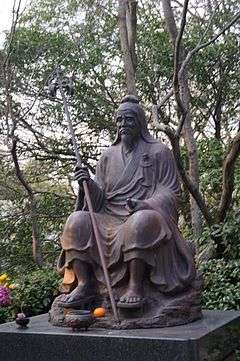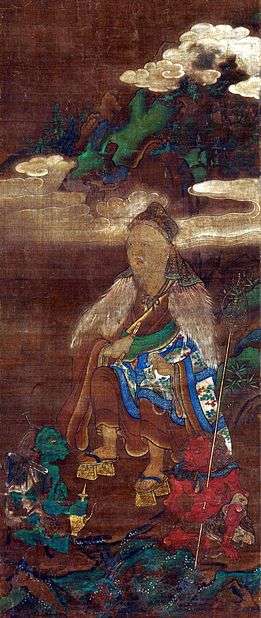En no Gyōja

En no Ozunu, also En no Ozuno, Otsuno (役小角) (b. 634, in Katsuragi; d. c. 700–707) was a Japanese ascetic and mystic, traditionally held to be the founder of Shugendō, the path of ascetic training practiced by the gyōja or yamabushi.
He was banished by the Imperial Court to Izu Ōshima on June 26, 699, but folk tales at least as old as the Nihon Ryōiki (c. 800) recount his supernatural powers and exploits.
He also referred to by the name En no Gyōja (役行者 "En the ascetic"), En no Ubasoku (役優婆塞 "En the lay monk") , or under the full name En no Kimi Ozunu, where Kimi (君) is his kabane or titular name.
Historical references
Even historical accounts of his life are intermixed with legends and folklore. According to the chronicle Shoku Nihongi (797 AD), En no Ozunu was banished to the island of Izu Ōshima on June 26, 699:
On hinoto-ushi (sexagenary "fire ox") day[lower-alpha 1] [24th day of the 5th month, Mommu 3 (June 26, 699 AD)], En no Kimi Ozunu was banished to Izu no Shima. Ozunu had first lived in Mount Katsuragi and been acclaimed for his sorcery and was the teacher of Outer Junior 5th Rank Lower Grade Karakuni no Muraji Hirotari. Later, [a person (or Hirotari?)] envied his power and accused him of trickery with his weird magic. [The Imperial Court] banished him far [from the Capital]. Rumor says, "Ozunu was able to manipulate demonic spirits, making them draw water and gather firewood. When they disobeyed, he bound them using sorcery."[1]
In spite of this incident, it seems that the Court continued to highly evaluate the herbal knowledge of Ozunu's school, since Vol. 11 of the book also tells that on October 5, Tenpyō 4 (October 28, 732 AD), his student Karakuni no Hirotari was elected as the Head Apothecary (典薬頭 Ten'yaku no Kami), the highest position in Agency for Apothecary (典薬寮 Ten'yaku-ryō).[2]
In the religion Shugendō

In folk religion, En no Ozunu is traditionally held to be the founder of Shugendō,[3] a syncretic religion incorporating aspects of Taoism, Shinto, esoteric Buddhism (especially Shingon Mikkyō and the Tendai sect) and traditional Japanese shamanism.[4]
En no Gyōja was conferred the posthumous title Jinben Daibosatsu (Great Bodhisattva Jinben, 神変大菩薩) at a ceremony held in 1799 to commemorate the one-thousandth year of his passing. Authorship of the non-canonical Sutra on the Unlimited Life of the Threefold Body is attributed to En no Gyōja. Due to his mythical status as a mountain saint, he was believed to possess many supernatural powers.[5]
In popular culture
- In the historical fantasy novel Teito Monogatari by Hiroshi Aramata the protagonist Yasunori Kato claims to be a descendant of En no Gyōja.
- In the manga OZN by Shiro Ohno the protagonist is a superheroic version of En no Ozunu.
- In the SNES game Shin Megami Tensei, an NPC named En-no-ozuno resides in Kongokai.
- In the PS1 game Oni Zero: Fukkatsu, the main antagonist is En no Gyōja.
- In Koji Suzuki's novel Ring, Sadako's mother drags a statuette of En no Ozunu from the sea.
Explanatory notes
- ↑ See Sexagenary cycle#Problems with English translation. The sequential number for "fire ox" may be 14th, but this does not determine the day of month, because it is continuously carried over, and does not reset to zero at the start of each month.
References
| Wikimedia Commons has media related to En no Ozunu. |
- Citations
- ↑ Keizai Zasshisha, ed. (1897), 續日本紀 [Shoku Nihongi], 國史大系 [Grand Collection of National History] (in Chinese), 2, p. 7,
丁丑。役君小角流于伊豆島。初小角住於葛木山。以咒術稱。外從五位下韓國連廣足師焉。後害其能。讒以妖惑。故配遠處。世相傳云。小角能役使鬼神。汲水採薪。若不用命。即以咒縛之。
- ↑ Keizai Zasshisha 1897, 續日本紀 [Shoku Nihongi], p.189 (Chinese)
- ↑ Keenan 1989, 2, 171–172
- ↑ Blacker, Carmen. The Catalpa Bow. 2nd ed. London: George Allen & Unwin, 1986.
- ↑ Kodansha, Encyclopedia of Japan. Vol.2, Tokyo, 1983.
- Bibliography